Gonatus ursabrunae
F. G. Hochberg and Richard E. YoungIntroduction
G. ursabrunae is known from 16 juvenile squid ranging in size from 12-25 mm ML.Diagnosis
A juvenile Gonatus with ...
- enlarged suckers in marginal sucker series of arms I-III.
- large suckers on the club dactylus.
Characteristics
- Arms
- Suckers of medial two series of arms I-III small (0.18-0.20 mm in diameter); suckers of marginal series enlarged (0.50 mm in diameter) in middle third of arms.
- Enlarged suckers with 9-16 short, blunt teeth on distal margin.
- Arm IV suckers smaller (0.10-0.12) than medial suckers of other arms; medial and marginal suckers of arm IV equal in size.
- No hooks are present on the arms.
 Click on an image to view larger version & data in a new window
Click on an image to view larger version & data in a new window

Figure. Oral view of arms of G. ursabrunae. Top - Holotype, 24 mm ML, preserved. Photograph by R. Young. Bottom - Arm IIIk, 19 mm ML. Drawing from Jefferts (1985).
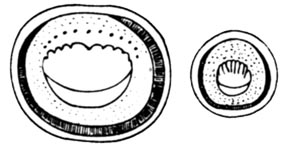
Figure. Oral view of arm III suckers of G. ursabrunae, 19 mm ML. Left - Enlarged sucker of marginal series. Right - Small sucker of medial series. Drawing from Jefferts (1985).
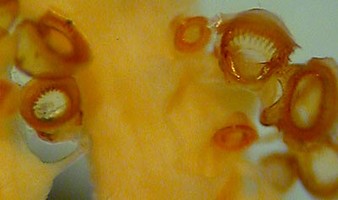
Figure. Oral view of arm suckers of G. ursabrunae, holotype, preserved. Photograph by R.Young.
- Tentacles
- Dactylus with ca. six sucker series just distal to central hook, decreasing to four series over most of dactylus.
- Largest dactylus suckers reach very large size of 0.3 mm (24 mm ML) in diameter.
- Suckers of dactylus (ie, distal to central hook) number about 110.
- Medial zone of club with central hook or enlarged sucker; proximal series of three or four suckers.
- Dorsal marginal zone with suckers in four series.
- Ventral marginal zone with suckers in four or five series.
- Carpal locking-apparatus with about five ridges and suckers.
- Dorsal series of stalk with ca. 28 suckers; ventral series with ca. 25 suckers; medial zone with ca. 57 suckers. Counts from 19 mm ML squid.
- Dactylus with ca. six sucker series just distal to central hook, decreasing to four series over most of dactylus.
- Head
- Beaks
- Radula
- Radula with teeth in five series; rhachidian tricuspid; lateral tooth 2 and marginal tooth simple.
- Central cusp of rhachidian tooth off-center, alternating sides in successive teeth (ie, 2nd and 4th teeth aligned as are 1st and 3rd).
- Photophores
- Photophores absent
Comments
Except for the photographs, the above description is taken from Jefferts (1985). More details of the description can be found here.
Jefferts places G. ursabrunae in Gonatus (sensu stricto) on the basis of the presumptive central hook on the club and the 5 part radula. She separates it from other North Pacific Gonatus (G. onyx, G. madokai, G. californiensis, G. middendorffi and G. oregonensis) of comparable size by their lack of enlarged brachial and club suckers and from G. pyros by its ocular photophores and G. berryi by its arm hooks at comparable size.
The peculiar large lateral arm suckers may not be as distinct as first believed. We have seen such suckers on a 32 mm ML G. middendorffi in the distal third of the arms (see below). This squid, however, had very different clubs from those of G. ursabrunae especially in the very tiny, numerous and equal-sized suckers of the dactylus (see the G. middendorffi page).

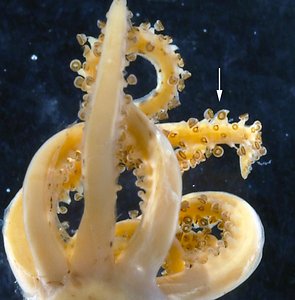
Figure. Oral view of the arm tip of G. middendorffi, 32 mm ML, southeast of Adak Isl, Aleutian Isl. Hooks are just beginning to develop on the arms. Photograph by R. Young.
G. ursabrunae clearly is not the young stage of any North Pacific species of Gonatus. Comparable sizes of Eogonatus tinro, however, are not known. Although unlikely, the presumptive central hook in the club of G. ursabrunae, the feature which places it in Gonatus, could disappear with growth.
Life History
Small squid have a spindle-shaped, obliquely oriented digestive gland.
The central hook on the tentacular club develops at 20-24 mm ML. Other hooks develop at sizes greater than 24 mm ML.
References
Jefferts, K. 1985. Gonatus ursabrunae and Gonatus oregonensis, Two New Species of Squids from the Northeastern Pacific Ocean (Cephalopoda: Oegopsida: Gonatidae). Veliger, 28(2):159-174.
Okutani, T., T. Kubodera and K. Jefferts. 1983. Diversity, distribution and ecology of gonatid squids in the subarctic Pacific: A review. Bull. Ocean Res. Inst., Univ. Tokyo, No. 26 (1):150-192.
About This Page
F. G. Hochberg

Santa Barbara Museum of Natural History, Santa Barbara, California, USA

University of Hawaii, Honolulu, HI, USA
Page copyright © 2016 F. G. Hochberg and
All Rights Reserved.
- First online 31 May 2006
- Content changed 31 May 2006
Citing this page:
Hochberg, F. G. and Richard E. Young. 2006. Gonatus ursabrunae . Version 31 May 2006. http://tolweb.org/Gonatus_ursabrunae/19776/2006.05.31 in The Tree of Life Web Project, http://tolweb.org/







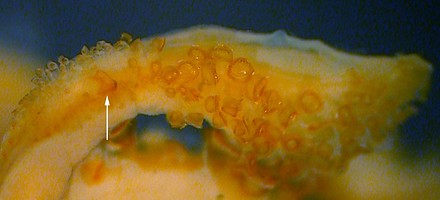
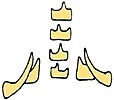
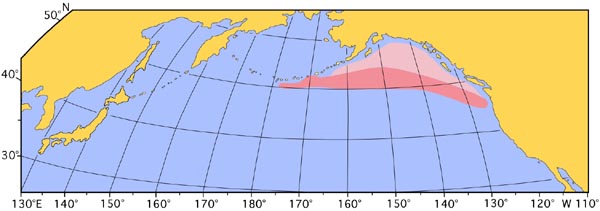



 Go to quick links
Go to quick search
Go to navigation for this section of the ToL site
Go to detailed links for the ToL site
Go to quick links
Go to quick search
Go to navigation for this section of the ToL site
Go to detailed links for the ToL site